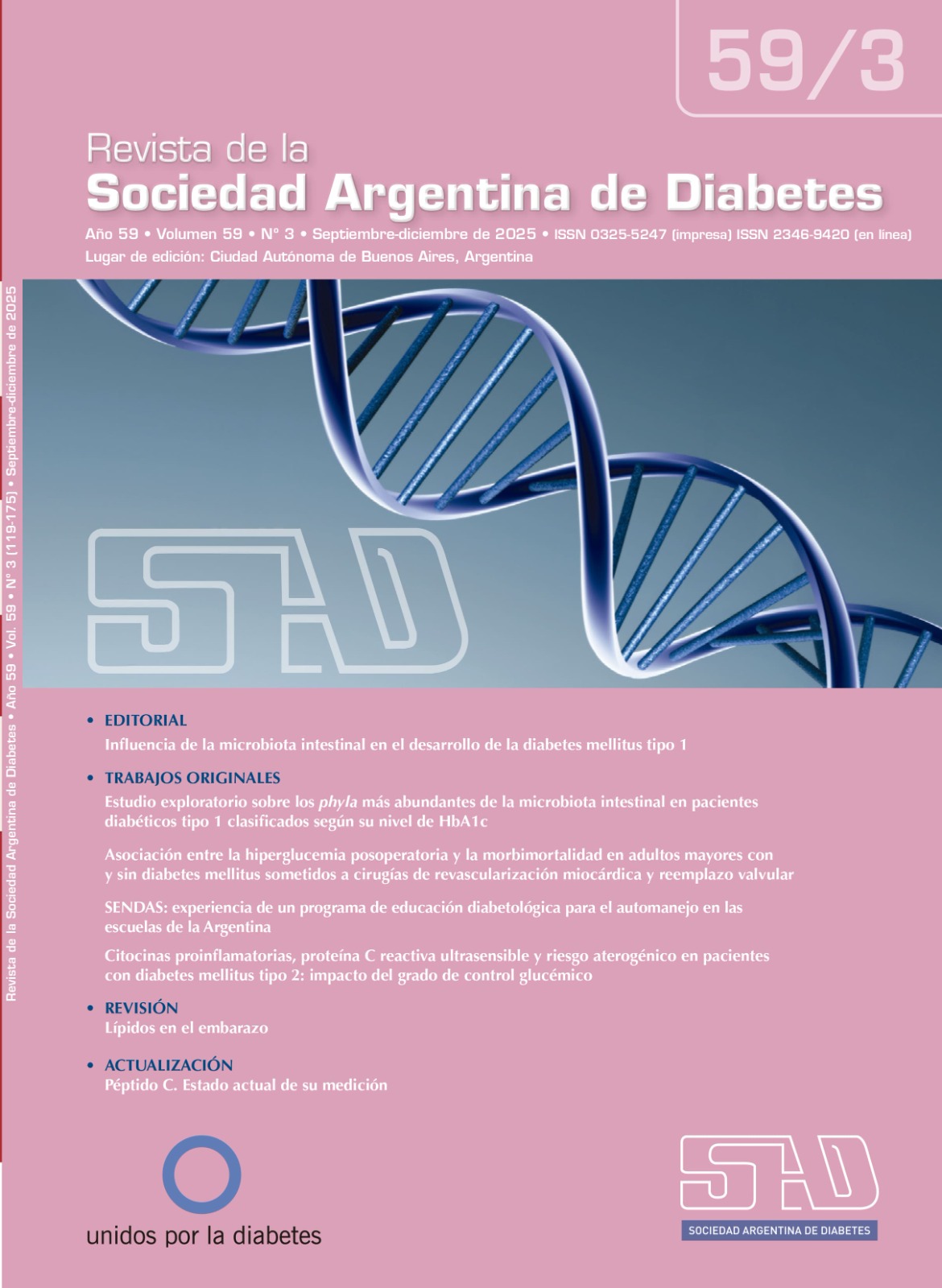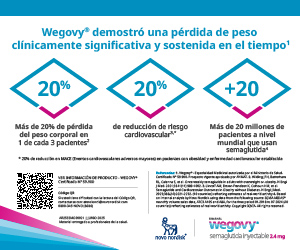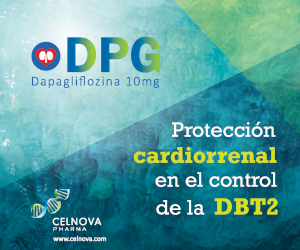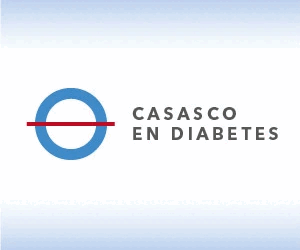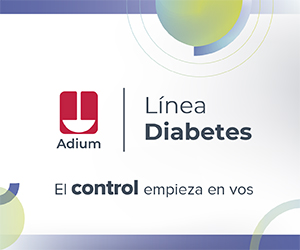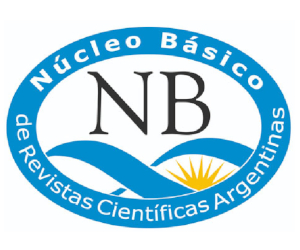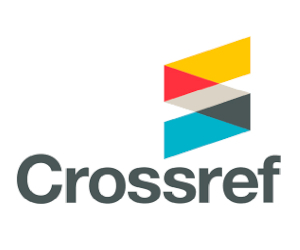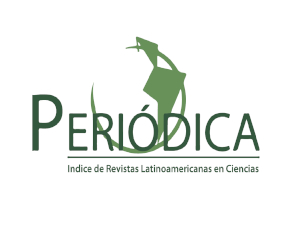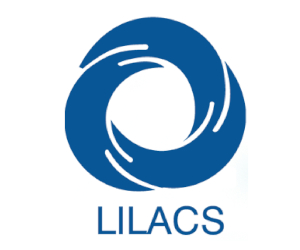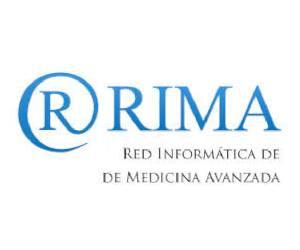C-peptide. Current status of its measurement
DOI:
https://doi.org/10.47196/diab.v59i3.1291Keywords:
C-peptide, diagnosis, diabetes mellitus, follow-upAbstract
C-peptide is formed together with insulin in the β-cells of the pancreas by enzymatic cleavage of proinsulin. Both are released in equimolar amounts into the blood, but C-peptide has a longer half-life (20-30 minutes), which makes it a more reliable marker than insulin for endogenous insulin production and also to assess pancreatic function because of its stability. Its measurement can be performed in blood or urine, and it is important to consider variation factors such as renal function when interpreting the results. Although C-peptide is a valuable tool in endocrinology and clinical research, its determination is not routine in daily clinical practice until the process of standardization of the methods used is completed.
References
I. Hörber S, Achenbach P, Schleicher E, Peter A. Harmonization of immunoassays for biomarkers in diabetes mellitus. Biotechnol Adv 2020;39(107359):107359. doi: 10.1016/j.biotechadv.2019.02.015.
II. Steiner DF, Park S-Y, Støy J, Philipson LH, Bell GI. A brief perspective on insulin production. Diabetes Obes Metab 2009;11(Suppl 4):189-96. doi: 10.1111/j.1463-1326.2009.01106.x.
III. Leighton E, Sainsbury CA, Jones GC. A practical review of C-peptide testing in diabetes. Diabetes Ther 2017;8(3):475-87. doi: 10.1007/s13300-017-0265-4.
IV. Muzzio ML, Meroño T. Características y utilidad clínica de la medida del péptido C. Bioquim Patol Clin 2020;84(1):39-48. doi: 10.62073/bypc.v84i1.36.
V. Ahlqvist E, Storm P, Käräjämäki A, Martinell M, Dorkhan M, Carlsson A, et al. Novel subgroups of adult-onset diabetes and their association with outcomes: a data-driven cluster analysis of six variables. Lancet Diabetes Endocrinol 2018;6(5):361-9. doi: 10.1016/S2213-8587(18)30051-2.
VI. Hörber S, Orth M, Fritsche A, Peter A. Comparability of C-peptide measurements - current status and clinical relevance. Exp Clin Endocrinol Diabetes 2023;131(3):173-8. doi: 10.1055/a-1998-6889.
VII. Venugopal SK, Mowery ML, Jialal I. Biochemistry, C peptide. En: StatPearls. Treasure Island (FL): StatPearls Publishing; 2024.
VIII. Ramos EL, Dayan CM, Chatenoud L, Sumnik Z, Simmons KM, Szypowska A, et al. Teplizumab and β-cell function in newly diagnosed type 1 diabetes. N Engl J Med 2023;389(23):2151-61. doi: 10.1056/NEJMoa2308743.
IX. Bluestone JA, Buckner JH, Herold KC. Immunotherapy: Building a bridge to a cure for type 1 diabetes. Science 2021;373(6554):510-6. doi: 10.1126/science.abh1654.
X. Maddaloni E, Bolli GB, Frier BM, Little RR, Leslie RD, Pozzilli P, et al. C-peptide determination in the diagnosis of type of diabetes and its management: a clinical perspective. Diabetes Obes Metab 2022;24(10):1912-26. doi: 10.1111/dom.14785.
XI. Little RR, Wielgosz RI, Josephs R, Kinumi T, Takatsu A, Li H, et al. Implementing a reference measurement system for C-peptide. Successes and lessons learned. Clin Chem 2017;63(9):1447-56. doi: 10.1373/clinchem.2016.269274.
XII. Little RR, Kinumi T, Connolly S, Kabytaev K. Implementing a reference measurement system for C-peptide: an addendum. Clin Chem 2017;63(12):1904-5. doi: 10.1373/clinchem.2017.281170.
Downloads
Published
Issue
Section
License
Copyright (c) 2025 on behalf of the authors. Reproduction rights: Argentine Society of Diabetes

This work is licensed under a Creative Commons Attribution-NonCommercial-NoDerivatives 4.0 International License.
Dirección Nacional de Derecho de Autor, Exp. N° 5.333.129. Instituto Nacional de la Propiedad Industrial, Marca «Revista de la Sociedad Argentina de Diabetes - Asociación Civil» N° de concesión 2.605.405 y N° de disposición 1.404/13.
La Revista de la SAD está licenciada bajo Licencia Creative Commons Atribución – No Comercial – Sin Obra Derivada 4.0 Internacional.
Por otra parte, la Revista SAD permite que los autores mantengan los derechos de autor sin restricciones.



